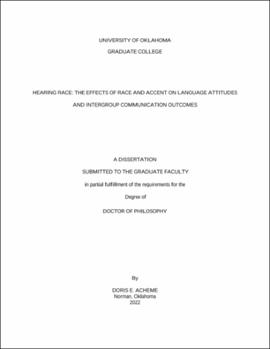| dc.description.abstract | Relying on assumptions from social identity theory (Tajfel & Turner, 1979), alongside integrated threat theory and intersectionality framework/theory, this dissertation investigated how speakers are socially categorized based on their accents (i.e., SAE [Standard American English] accent vs. Nigerian accent) and race (i.e., White vs. Black) separately and concurrently (i.e., White-SAE vs. Black-Nigerian) as well as the intergroup outcomes (i.e., symbolic threat, realistic threat, intergroup anxiety, and social distance) of these social categorizations, as mediated by language attitudes (i.e., evaluations of status, solidarity, and dynamism). Several pilot studies were conducted to generate pretest stimuli for the main experimental study. Audio samples were first generated, and photographs were selected for use in the dissertation study. Pilot Study 1 was conducted to pre-test and examine the prototypicality of both the SAE (N = 151) and Nigerian (N = 105) accents (while controlling for vocal attractiveness). Based on results from this pilot study, six final accent samples from the initial 14 samples gathered were selected for use in the main study. Pilot Study 2 pre-tested the prototypicality of White (N = 150) and Black (N = 152) male photographs (while controlling for physical attractiveness). Based on results from this pilot study, six final photographs (from the original 24 photographs) were selected for use in the main dissertation study.
For the main study, an experiment randomly assigning participants (N = 502) to one of 18 conditions (i.e., either accent-only, race-only, or accent-race conditions) examined the direct and indirect effects of accent, race, and accent and race combined on symbolic threat, realistic threat, intergroup anxiety, and social distance, as mediated by evaluations of status, solidarity, and dynamism. In the accent-only condition, participants were presented with an audio-recoding of either an SAE or a Nigerian accented speaker reading a passage of prose about rainbows. In the race-only conditions, a photograph of a White or Black male accompanied by the same rainbow passage was presented. Finally, in the accent-race conditions, participants were presented with either a photograph of a White male together with an audio-recording of an SAE accented speaker reading the rainbow passage or a photograph of a Black male together with an audio-recording of a Nigerian accented speaker reading the rainbow passage. After stimuli exposure, manipulation checks were first presented to participants, then participants were asked to answer a battery of measures, namely, speech evaluation instrument, symbolic threat, realistic threat, intergroup anxiety, social distance, exoticism, exposure to diverse individuals, attitudes toward African immigrants, and demographic questions.
Findings revealed that, for the accent-only conditions, the SAE accent was evaluated more favorably than the Nigerian accent on the dimension of status. Also, status was found to mediate the relationship between accent and symbolic threat. For the race-only conditions, results indicated that Black males were rated higher on solidarity and dynamism compared to White males. For the accent-race conditions, status mediated the relationship between the combined accent and race of a speaker and symbolic threat, intergroup anxiety, and social distance. In other words, lower status evaluations for Black-Nigerian accented speaker resulted in higher feelings of symbolic threat, greater intergroup anxiety, and more social distance from Black-Nigerian accented speakers, in general. The dissertation’s findings are discussed as they pertain to social categorization, stereotyping, intergroup communication outcomes, ideological beliefs about language use and racial cues, as well as the role that socio-cultural context plays in intergroup relations. Additionally, the theoretical and practical implications of the dissertation are discussed as they concern social identity markers of accent, race, and the intersectionality of accent and race in intergroup communication. Lastly, the limitations of the dissertation study are acknowledged and directions for future research are proposed. | en_US |

